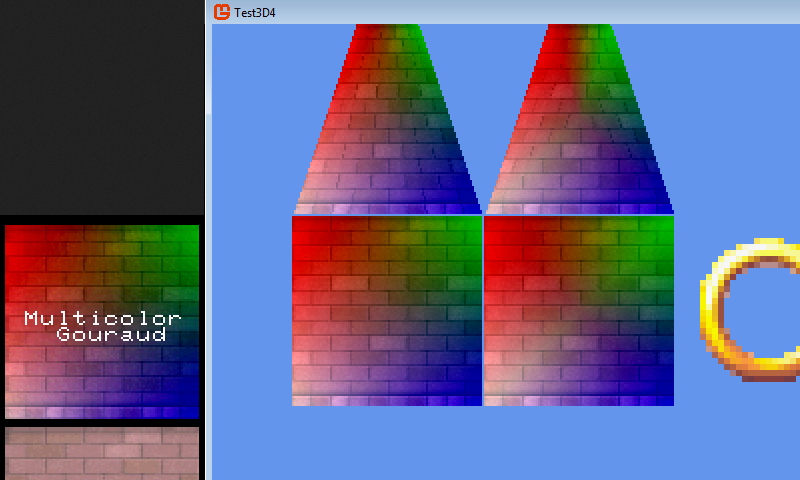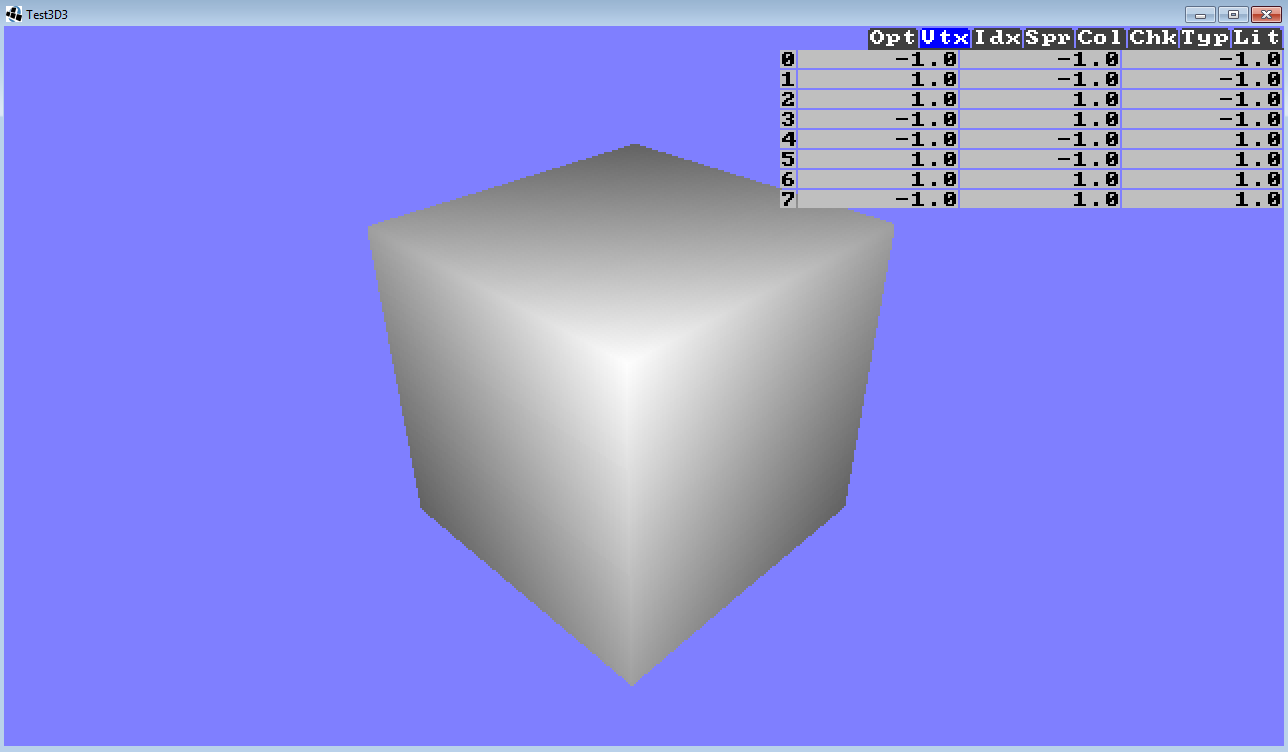1
Share your code / Monogame/HLSL Effect/Shader for Saturn-like graphics.
« on: July 30, 2018, 04:58:19 am »
https://github.com/Jorhlok/Test3D4
https://github.com/Jorhlok/Test3D4/blob/master/Test3D4/Content/assets/fx/Saturn.fx
The shader itself supports textured/untextured tris, additive/subtractive gouraud for textured tris, color goraud for untextured tris, screen doors style dithering transparency at different sizes, and configurable "magic pink" style transparency with any color. It's all in RGBA as of writing, so no indexed color or CLUTs at present. External to the shader are things like the depth buffer which is still useable.
Then using (too) many triangles you can get the same sprite distortion as the saturn.
Here's some screenshots showing what I mean. More here: https://github.com/Jorhlok/Test3D4/tree/master/screenshot



This code will draw quads with a variable number of horizontal strips. This is an improvement over my last thing which drew in pixel-thin strips and used the default shader so only had multiplicative gouraud and had to switch to a second framebuffer, draw, and mask over it to accomplish the dithering effect.
Anyways I was thinking of making a low poly 3D modeller/animator targeting saturn style graphics also supporting billboards and camera facing strips in model.
One thing I'm not sure of is how important indexed color effects may be or how they're used on the saturn.
Don't get your hopes up or anything, my last thing only had keyboard/table input, no saving or textures, and looked like this.

EDIT: Okay I've been reading some of the VDP1 User's Manual (thanks google and redacted) and I'm getting the difference between VDP1 CLUT and VDP2 Color Banks and also mixed RGB/indexed color in the same framebuffer. Also I noticed that "Table 5.3 Relationship between Gouraud Shading Table Settings and Correction Values" is lining up with how I got the shading to match up with the example in the gallery by using color values from 0.25f and 0.75f so the shader will add +-0.5f to any pixel. The "correction values" go from -16 to +15 or half of 5-bit color space.
Anyways, still not sure if it's worth working indexed color into the shader or if fudging it with software is good enough.
EDIT2: Okay after much reading and confusion over the VDP1 and VDP2 User's Manuals yesterday, I think I have a grip on the terminology. I'll briefly explain how I see it so call me out if I'm off base. "Color Bank" is just what the VDP1 calls the other bits in a pixel beyond the index specified by the image. This can be more significant bits in the CRAM index (up to 11 bits total index) and also color calc or other special bits. The VDP2 has 1024 or 2048 colors in CRAM. CLUTs are how the VDP1 decompresses a 4-bit image to arbitrary 16 bit patterns. They're specified with a pointer per draw call. I think much of my confusion was each chip calling the same thing by different names or treating the same data slightly differently.
Real quick, I noticed an error in my shader as of writing and that is a colored polygon is specified only by the vertex colors so if I were to take a blue quad and shade it light to dark, it would lose saturation in between. I need to add polygon color as a variable in the shader. I was also thinking about other changes to make. Other than dealing with indexed color, I was thinking, since each object drawn basically needs to reupdate the shader variables, I could specify all four quad vertecies as global variables and use inverse bilinear to calculate the uv coordinates to accomplish accurate texturing with out needing to draw in many, many strips. Like this example here: https://www.shadertoy.com/view/MsccD4
I don't think I said it before but the purpose of the shader is to experiment with saturn-like graphics but also could be used to co-develop an enhanced port of saturn homebrew or similar.
This comes into play with what I was thinking about implementing any indexed color in the shader. I was thinking that usually indexed color in a 3D saturn game is going to be used for the transparency effect and also saving VRAM. Transparency can be accomplished in RGBA and saving VRAM isn't an issue. Then I was thinking about advanced effects like that metallic shading XL2 showed off in Z-Treme recently. So finally I thought, "It sure would be a shame if an 'enhanced' port had to cut out effects," thus coming to my decision to try and implement CLUT and CRAM effects in the shader. It'll require some bullshittery with pulling integers of various sizes out of vector4 color but if anything is, a GPU is up to the task.
https://github.com/Jorhlok/Test3D4/blob/master/Test3D4/Content/assets/fx/Saturn.fx
The shader itself supports textured/untextured tris, additive/subtractive gouraud for textured tris, color goraud for untextured tris, screen doors style dithering transparency at different sizes, and configurable "magic pink" style transparency with any color. It's all in RGBA as of writing, so no indexed color or CLUTs at present. External to the shader are things like the depth buffer which is still useable.
Then using (too) many triangles you can get the same sprite distortion as the saturn.
Here's some screenshots showing what I mean. More here: https://github.com/Jorhlok/Test3D4/tree/master/screenshot



This code will draw quads with a variable number of horizontal strips. This is an improvement over my last thing which drew in pixel-thin strips and used the default shader so only had multiplicative gouraud and had to switch to a second framebuffer, draw, and mask over it to accomplish the dithering effect.
Anyways I was thinking of making a low poly 3D modeller/animator targeting saturn style graphics also supporting billboards and camera facing strips in model.
One thing I'm not sure of is how important indexed color effects may be or how they're used on the saturn.
Don't get your hopes up or anything, my last thing only had keyboard/table input, no saving or textures, and looked like this.

EDIT: Okay I've been reading some of the VDP1 User's Manual (thanks google and redacted) and I'm getting the difference between VDP1 CLUT and VDP2 Color Banks and also mixed RGB/indexed color in the same framebuffer. Also I noticed that "Table 5.3 Relationship between Gouraud Shading Table Settings and Correction Values" is lining up with how I got the shading to match up with the example in the gallery by using color values from 0.25f and 0.75f so the shader will add +-0.5f to any pixel. The "correction values" go from -16 to +15 or half of 5-bit color space.
Anyways, still not sure if it's worth working indexed color into the shader or if fudging it with software is good enough.
EDIT2: Okay after much reading and confusion over the VDP1 and VDP2 User's Manuals yesterday, I think I have a grip on the terminology. I'll briefly explain how I see it so call me out if I'm off base. "Color Bank" is just what the VDP1 calls the other bits in a pixel beyond the index specified by the image. This can be more significant bits in the CRAM index (up to 11 bits total index) and also color calc or other special bits. The VDP2 has 1024 or 2048 colors in CRAM. CLUTs are how the VDP1 decompresses a 4-bit image to arbitrary 16 bit patterns. They're specified with a pointer per draw call. I think much of my confusion was each chip calling the same thing by different names or treating the same data slightly differently.
Real quick, I noticed an error in my shader as of writing and that is a colored polygon is specified only by the vertex colors so if I were to take a blue quad and shade it light to dark, it would lose saturation in between. I need to add polygon color as a variable in the shader. I was also thinking about other changes to make. Other than dealing with indexed color, I was thinking, since each object drawn basically needs to reupdate the shader variables, I could specify all four quad vertecies as global variables and use inverse bilinear to calculate the uv coordinates to accomplish accurate texturing with out needing to draw in many, many strips. Like this example here: https://www.shadertoy.com/view/MsccD4
I don't think I said it before but the purpose of the shader is to experiment with saturn-like graphics but also could be used to co-develop an enhanced port of saturn homebrew or similar.
This comes into play with what I was thinking about implementing any indexed color in the shader. I was thinking that usually indexed color in a 3D saturn game is going to be used for the transparency effect and also saving VRAM. Transparency can be accomplished in RGBA and saving VRAM isn't an issue. Then I was thinking about advanced effects like that metallic shading XL2 showed off in Z-Treme recently. So finally I thought, "It sure would be a shame if an 'enhanced' port had to cut out effects," thus coming to my decision to try and implement CLUT and CRAM effects in the shader. It'll require some bullshittery with pulling integers of various sizes out of vector4 color but if anything is, a GPU is up to the task.

